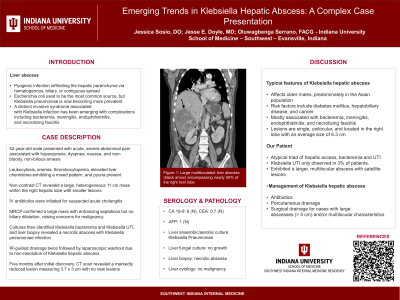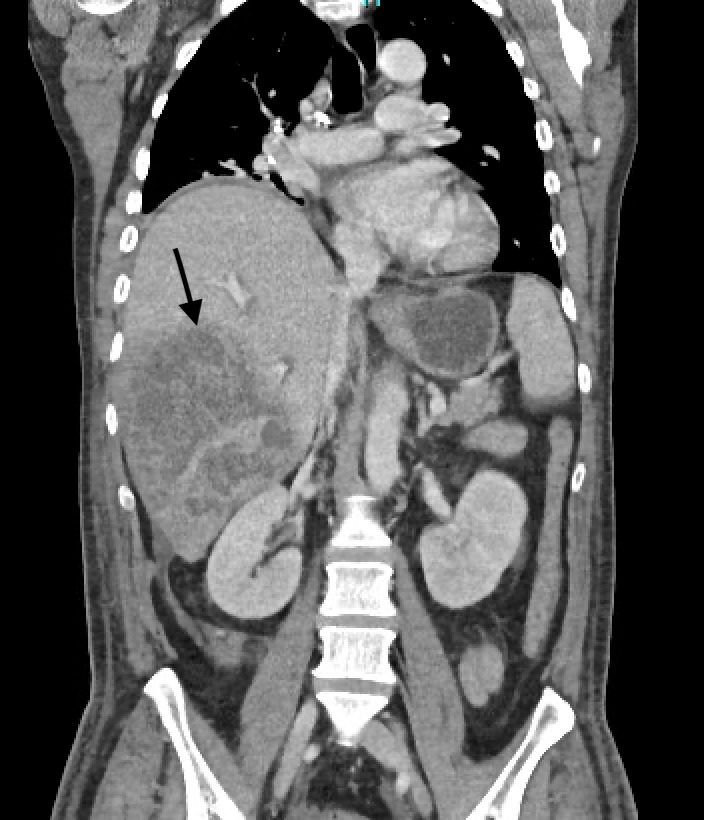Sunday Poster Session
Category: Liver
P1132 - Emerging Trends in Klebsiella Hepatic Abscess: A Complex Case Presentation
Sunday, October 22, 2023
3:30 PM - 7:00 PM PT
Location: Exhibit Hall

Has Audio

Jessica Sosio, DO
Indiana University
Evansville, IN
Presenting Author(s)
Jessica Sosio, DO1, Jesse E. Doyle, MD1, Oluwagbenga Serrano, FACG2
1Indiana University, Evansville, IN; 2Indiana University, Vincennes, IN
Introduction: Liver abscesses commonly result from pyogenic infections infiltrating the hepatic parenchyma via hematogenous, biliary, or contiguous spread. Historically, Escherichia coli has been the primary bacterium, but prevalence of Klebsiella pneumoniae has notably increased in recent years. Furthermore, a distinct invasive syndrome associated with Klebsiella infection has emerged, presenting complications such as bacteremia, meningitis, endophthalmitis, and necrotizing fasciitis. We present a case of a Klebsiella hepatic abscess (KHA) in a previously healthy patient complicated by Klebsiella bacteremia (KB) and an atypical association with Klebsiella urinary tract infection (KUTI).
Case Description/Methods: A 52-year-old male presented to the emergency department with acute, severe abdominal pain associated with hyperpyrexia, dyspnea, nausea, and non-bloody, non-bilious emesis. Initial workup revealed leukocytosis, anemia, thrombocytopenia, and liver chemistries displayed a mixed pattern. A non-contrast computed tomography (CT) scan revealed a large, heterogeneous 11 cm mass within the right hepatic lobe with smaller lesions. Urinalysis demonstrated pyuria. Intravenous antibiotics were initiated for suspected acute cholangitis and gastroenterology was consulted. Magnetic resonance cholangiopancreatography confirmed a large mass with enhancing septations but no biliary dilatation, raising concerns for malignancy. Subsequently, cultures identified KB and KUTI. Liver biopsy revealed a necrotic abscess with Klebsiella pneumoniae infection. Patient underwent interventional radiology-guided drainage twice followed by laparoscopic washout due to non-resolution of KHA. Five months after initial discovery, CT scan revealed a markedly reduced lesion measuring 3.7 x 3 cm with no new lesions.
Discussion: KHA primarily affects older males, predominately in the Asian population. Common risk factors for KHA include diabetes mellitus, hepatobiliary disease, and cancer. Our case is remarkable for its atypical triad of hepatic access, KB and KUTI. While bacteremia occurs in about 74% of KHA cases, urinary tract infection is observed in just 3% of patients. Typically, KHA lesions present as a single, unilocular mass located in the right lobe with an average size of 6.3 cm. In contrast, our patient exhibited a larger, multilocular abscess with satellite lesions. Management of KHA involves antibiotics, percutaneous drainage, and surgical drainage for cases with large abscesses (> 5 cm) and/or multilocular characteristics.

Disclosures:
Jessica Sosio, DO1, Jesse E. Doyle, MD1, Oluwagbenga Serrano, FACG2. P1132 - Emerging Trends in Klebsiella Hepatic Abscess: A Complex Case Presentation, ACG 2023 Annual Scientific Meeting Abstracts. Vancouver, BC, Canada: American College of Gastroenterology.
1Indiana University, Evansville, IN; 2Indiana University, Vincennes, IN
Introduction: Liver abscesses commonly result from pyogenic infections infiltrating the hepatic parenchyma via hematogenous, biliary, or contiguous spread. Historically, Escherichia coli has been the primary bacterium, but prevalence of Klebsiella pneumoniae has notably increased in recent years. Furthermore, a distinct invasive syndrome associated with Klebsiella infection has emerged, presenting complications such as bacteremia, meningitis, endophthalmitis, and necrotizing fasciitis. We present a case of a Klebsiella hepatic abscess (KHA) in a previously healthy patient complicated by Klebsiella bacteremia (KB) and an atypical association with Klebsiella urinary tract infection (KUTI).
Case Description/Methods: A 52-year-old male presented to the emergency department with acute, severe abdominal pain associated with hyperpyrexia, dyspnea, nausea, and non-bloody, non-bilious emesis. Initial workup revealed leukocytosis, anemia, thrombocytopenia, and liver chemistries displayed a mixed pattern. A non-contrast computed tomography (CT) scan revealed a large, heterogeneous 11 cm mass within the right hepatic lobe with smaller lesions. Urinalysis demonstrated pyuria. Intravenous antibiotics were initiated for suspected acute cholangitis and gastroenterology was consulted. Magnetic resonance cholangiopancreatography confirmed a large mass with enhancing septations but no biliary dilatation, raising concerns for malignancy. Subsequently, cultures identified KB and KUTI. Liver biopsy revealed a necrotic abscess with Klebsiella pneumoniae infection. Patient underwent interventional radiology-guided drainage twice followed by laparoscopic washout due to non-resolution of KHA. Five months after initial discovery, CT scan revealed a markedly reduced lesion measuring 3.7 x 3 cm with no new lesions.
Discussion: KHA primarily affects older males, predominately in the Asian population. Common risk factors for KHA include diabetes mellitus, hepatobiliary disease, and cancer. Our case is remarkable for its atypical triad of hepatic access, KB and KUTI. While bacteremia occurs in about 74% of KHA cases, urinary tract infection is observed in just 3% of patients. Typically, KHA lesions present as a single, unilocular mass located in the right lobe with an average size of 6.3 cm. In contrast, our patient exhibited a larger, multilocular abscess with satellite lesions. Management of KHA involves antibiotics, percutaneous drainage, and surgical drainage for cases with large abscesses (> 5 cm) and/or multilocular characteristics.

Figure: Figure 1: Large multiloculated liver abscess (black arrow) encompassing nearly 50% of the right liver lobe.
Disclosures:
Jessica Sosio indicated no relevant financial relationships.
Jesse Doyle indicated no relevant financial relationships.
Oluwagbenga Serrano indicated no relevant financial relationships.
Jessica Sosio, DO1, Jesse E. Doyle, MD1, Oluwagbenga Serrano, FACG2. P1132 - Emerging Trends in Klebsiella Hepatic Abscess: A Complex Case Presentation, ACG 2023 Annual Scientific Meeting Abstracts. Vancouver, BC, Canada: American College of Gastroenterology.
